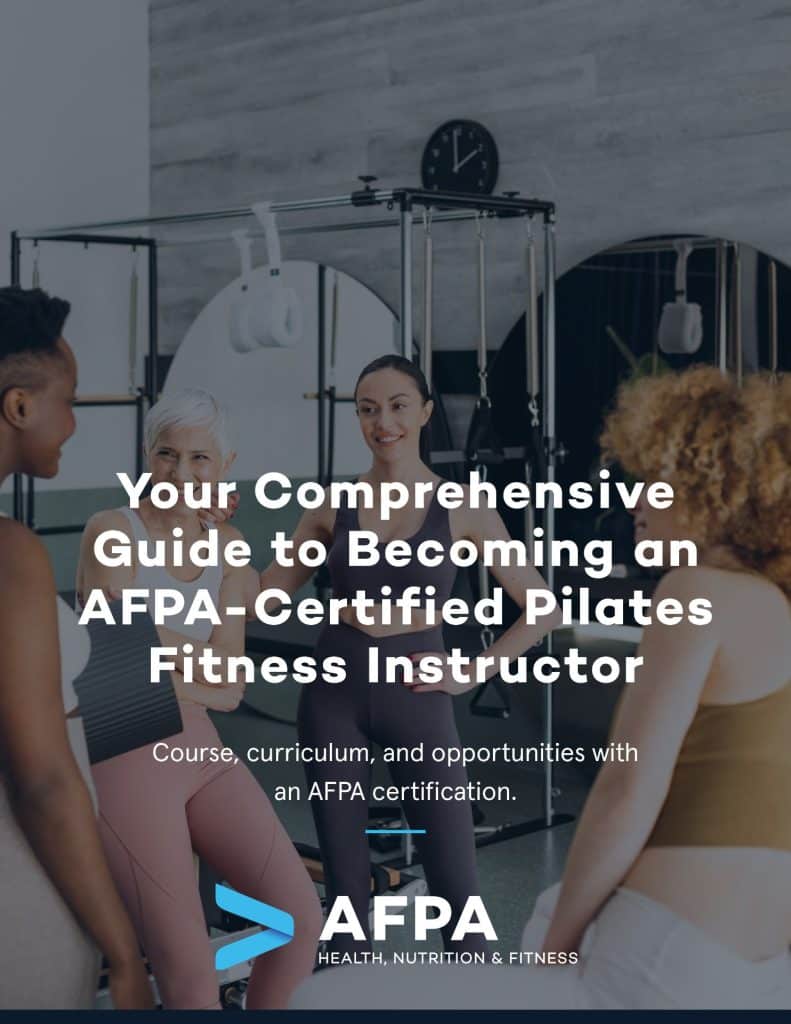Pilates is one of the most popular methods of exercise in the world, and for good reason. Since its creation in the early 20th century, Pilates has become a favorite workout for health-minded individuals who want to build strength, lean muscle tone, and flexibility—all with a focus on the core. In 2017 alone, more than 9 million people were participating in Pilates training.
If you’re excited to learn more about Pilates and want to help others lengthen and align their body, improve their posture and achieve total body conditioning, then it’s time to pursue your Pilates instructor certification. Read on to learn how to become a certified Pilates instructor.
The Origins of Pilates
German-born Joseph Pilates began to develop his Pilates Method during World War I while in a forced internment camp in England. Although he had been sickly as a child, Joseph Pilates was an accomplished circus performer who was praised for his physique and commitment to fitness. While interned in England, Joseph Pilates worked to rehabilitate fellow detainees who were suffering from a variety of illnesses. He was an expert at using what little was at his disposal, including beer keg rings, chairs, and bed springs, and these simple, unsuspecting items would later inform the development of his Pilates Method.
During his detention, Joseph Pilates was constantly evolving his self-improvement systems, pulling from his understanding of anatomy, various Eastern practices, and his own commitment to body building and outdoor activities such as skiing, as well as the ancient Greek view of man as the perfect balance of body, mind, and spirit. After World War I he moved to the U.S. and solidified the Pilates Method with his wife, Clara, a nurse. From 1926 to 1966, Joseph Pilates taught in New York, training an entire generation of Pilates teachers on the “classical style” of Pilates. Since Joseph Pilates’ death in 1967, generations of contemporary Pilates instructors have evolved and built upon the strong foundation he created.
The Types of Pilates
At the core of the Joseph Pilates’ method is mat Pilates, which uses the body’s weight as resistance and works the upper and lower back muscles, legs, and stomach. Although most beginning students start with mat Pilates, there are more complex approaches that integrate different tools and machines developed by Joseph Pilates and his contemporaries to work different areas of the body based on resistance levels.
For example, reformer Pilates uses a narrow bed called a “reformer” that is equipped with a sliding carriage, straps, and pulleys. The resistance comes from adding or removing springs. Reformer Pilates helps with strength, flexibility, balance, posture, endurance training, and more. The Pilates chair is another popular piece of resistance equipment, offering countless exercise options in standing, sitting, and lying positions. The Pilates chair is a great resource for strengthening the core, arms, and legs.
A Pilates mat certification will give you the skills and tools to teach group mat classes, which are the type of classes offered in most gyms and fitness centers. Whether your ultimate goal is to work one-on-one with clients or to teach in a gym environment,a mat Pilates certification is the perfect career-launching option.
Here are six easy steps for getting your Pilates certification and launching your career as a Pilates instructor in this booming $11-billion industry.

Learn How to Become a Pilates Instructor Online in Less Than 6 Months
1. Decide what kind of Pilates instructor you’d like to be.
The best way to determine what kind of instructor you’d like to be, immerse yourself in as many classes as you can to learn the exercises and watch how the instructors interact with their clients. Watching other instructors is one of the best ways to determine what kind of Pilates instructor you’d like to be. Additionally, you can gauge whether you want to teach one-on-one or group classes and whether you’d like to work in a niche, such as Pilates for seniors or expectant mothers. Once you’ve taken a few classes and know how you’d like to specialize and what kind of teacher you’d like to be, it’s time to decide which type of Pilates instructor training you want to pursue.
2. Choose the right Pilates certification program.
Once you know the type of instructor you’d like to be and the type of certification you’d like to pursue, it’s time to research specific Pilates certification programs. The right Pilates instructor training should include a robust curriculum covering these topics:
- The origins and evolution of Pilates
- The basic principles and applications of Pilates
- The anatomy and physiology principles related to Pilates
- The core stabilizing muscles used for different exercises
- Basic Pilates mat exercises for group and one-on-one settings
- How to use Pilates exercises to address overuse injuries, arthritis, postural disorders, lower back pain, and misalignment issues
- The ability to identify client readiness for specific mat exercises
- How to implement best practices, fitness resources, and equipment
- How to communicate effectively and professionally with clients
As a Pilates instructor, you’ll obtain the skills to plan a class, provide posture corrections, build confidence in your students, and so much more.
4. Study, take the exam, and get certified as a Pilates instructor.
Getting certified in mat Pilates should take six months or less, and your program will likely consist of a variety of learning modules, comprehensive manuals, quizzes, video lessons, and a final written exam that you can take at your convenience. While you’re going through the course, we recommend finding a mentor, engaging with other Pilates instructors, and following relevant social media accounts. Staying active and engaged in the larger Pilates community will prepare you to launch your career as a Pilates instructor from the moment you pass your exam and receive your certification.
5. Purchase liability insurance.
Once you’re certified, it’s important to secure liability insurance. Commercial general liability (CGL) insurance will protect you against third-party injury claims, and professional liability insurance (PLI) will protect you against claims relating to injuries that your clients might experience while training with you. Additionally, if you’re working with a reformer or other piece of Pilates equipment, you’ll want to purchase product liability insurance, too.
6. Pursue continuing and supplemental education.
As a certified Pilates instructor, it’s important to get re-certified to stay up to date on your credentials. Although Pilates instruction is an unregulated industry, staying certified gives your clients, your potential employer, and your business the peace of mind that comes with knowing you are credible, reliable, and professional. Additionally, taking continuing education Pilates courses means you’ll stay current on relevant trends in the Pilates field so you can provide your clients with the best classes possible.
With these six steps, you’re ready to turn your love of fitness and helping others achieve their health and wellness goals into a successful career as a Pilates instructor.




